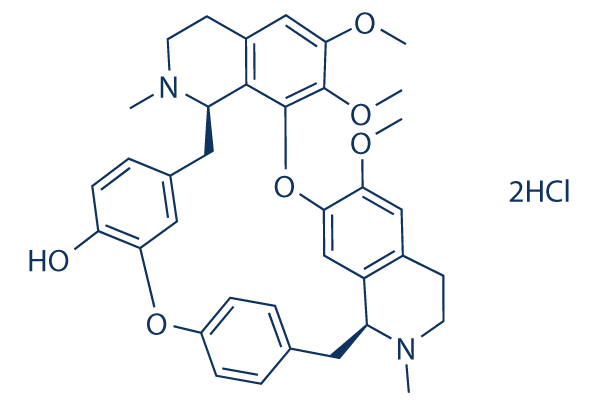|
受注:045-509-1970 |
技術サポート:[email protected] 平日9:00〜18:00 1営業日以内にご連絡を差し上げます |
化学情報

|
Synonyms | BA, BBM | Storage (From the date of receipt) |
3 years -20°C powder 1 years -80°C in solvent |
| 化学式 | C37H40N2O6.2HCl |
|||
| 分子量 | 681.65 | CAS No. | 6078-17-7 | |
| Solubility (25°C)* | 体外 | DMSO | 100 mg/mL (146.7 mM) | |
| Water | 100 mg/mL (146.7 mM) | |||
| Ethanol | Insoluble | |||
|
* <1 mg/ml means slightly soluble or insoluble. * Please note that Selleck tests the solubility of all compounds in-house, and the actual solubility may differ slightly from published values. This is normal and is due to slight batch-to-batch variations. |
||||
溶剤液(一定の濃度)を調合する
生物活性
| 製品説明 | Berbamine (BA, BBM) dihydrochloride, a traditional Chinese medicines extracted from Berberis amurensis (xiaoboan), is a novel inhibitor of bcr/abl fusion gene with potent anti-leukemia activity and also an inhibitor of NF-κB. Berbamine (BA, BBM) dihydrochloride induces apoptosis in human myeloma cells and inhibits the growth of cancer cells by targeting Ca²⁺/calmodulin-dependent protein kinase II (CaMKII). |
|---|---|
| in vitro | Berbamine (BBM) potently suppresses liver cancer cell proliferation and induces cancer cell death by targeting Ca2+/calmodulin-dependent protein kinase II (CAMKII). Through targeting CAMKII, BBM's inhibition on cancer cells might have broader effects beyond affecting JAK/STAT3 and p210bcr-abl, because CAMKIIγ directly impacts many other signal pathways including STAT1, NF-κB, JNK, ERK1/2, FOXO1, and Wnt/β-catenin[1]. BBM can effectively inhibit tumor metastasis by suppressing cell proliferation, migration and invasion in highly metastatic breast cancer cells under in vitro condition[2]. Berbamine inhibits proliferation of K562-r cells both in vitro and in vivo. Berbamine-induced apoptosis in K562-r cells appear to occur through a mechanism involving Bcl-2 family proteins, as well as mdr-1 mRNA and P-gp protein. Berbamine in combination with imatinib restore the chemo-sensitivity of K562-r cells to imatinib[3]. |
| in vivo | BBM inhibits the in vivo tumorigenicity of liver cancer cells in NOD/SCID mice, and down-regulated the self-renewal abilities of liver cancer initiating cells[1]. BBM shows its anticancer activity by induction of apoptosis, cell cycle arrest and reversing multidrug resistance. Though BBM is a potent drug but its half-life in blood plasma is very short, owing to its quick renal clearance[2]. |
プロトコル(参考用のみ)
| 細胞アッセイ | 細胞株 | epithelial liver cancer cell lines, including Huh7, HepG2, MHCC97H, and PLC/PRF/5 |
|---|---|---|
| 濃度 | 0-80 μg/ml | |
| 反応時間 | 72 h | |
| 実験の流れ | Cell proliferation is assayed 72 hours after BBM treatment for liver cancer cells with epithelial morphology. |
|
| 動物実験 | 動物モデル | NOD/SCID mouse |
| 投薬量 | 100 mg/kg | |
| 投与方法 | oral |
参考
長期の保管のために-20°Cの下で製品を保ってください。
人間や獣医の診断であるか治療的な使用のためにでない。
各々の製品のための特定の保管と取扱い情報は、製品データシートの上で示されます。大部分のSelleck製品は、推薦された状況の下で安定です。製品は、推薦された保管温度と異なる温度で、時々出荷されます。長期の保管のために必要とされてそれと異なる温度で、多くの製品は、短期もので安定です。品質を維持するが、夜通しの積荷のために最も経済的な貯蔵状況を用いてあなたの送料を保存する状況の下に、製品が出荷されることを、我々は確実とします。製品の受領と同時に、製品データシートの上で貯蔵推薦に従ってください。
